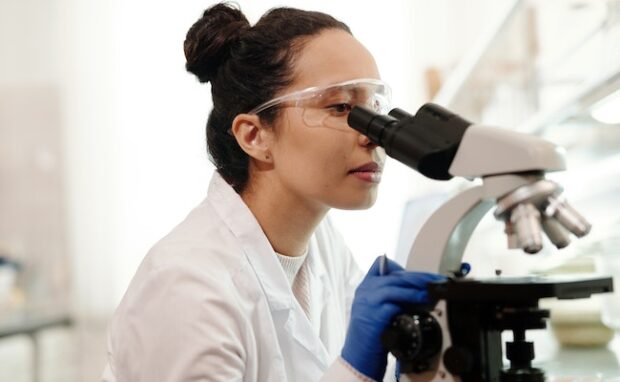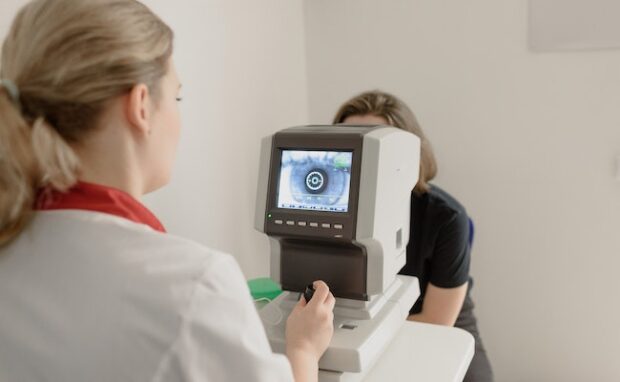AI-powered microscope detects cancer cells automatically
The US Department of Defense partnered with Google to create an AI microscope. The Augmented Reality Microscope or ARM outlines cancer cells using a bright green line. Also, its artificial intelligence systems estimate a cancer’s severity and generate a monochrome heat map on the monitor to show its boundaries.
Imagine the implications of having a microscope that detects microscopic organisms and objects automatically. Previously, you’d have to take minuscule samples and drag your microscope slide carefully to find them. Once the ARM enters consumer markets, it could reduce hospital workloads and improve healthcare worldwide.
This article will discuss Google and the DoD’s AI-powered microscope. Then, I will share other AI healthcare solutions that are active and in development, such as one that facilitates antibody treatment creation.
What do we know about the AI microscope?
The ARM is still undergoing testing and development, so we have little information about it. Fortunately, CNBC demonstrated the Augmented Reality Microscope at a Mitre facility in August.
The AI microscope seems like a regular one you’d find in a high school biology class. The machine is beige with a large eyepiece and a tray for conventional glass slides.
However, it connects to a large computer tower containing AI models. The artificial intelligence system outlines where a cancer is located once you fix a glass slide under the device.
Pathologists can view that outline as a bright green line through their eyepiece on a separate monitor. Moreover, the AI estimates the cancer’s severity and generates a black-and-white heat map.
The latter shows the borders of a cancer on a monitor. A senior autonomous systems engineer at Mitre, Patrick Minot, said the ARM doesn’t interfere with a pathologist’s established workflow.
The easy utility is an intentional design choice meant to deal with recent pathologist problems. Pathologists have been struggling with workforce shortages, like other healthcare sectors.
Meanwhile, their workloads have also been increasing as more people grow older. Both problems could require them to juggle several tasks, reducing their focus.
As a result, they’re more likely to make mistakes and pose serious risks to patients. CNBC says numerous organizations have been trying to digitize pathologist workflows to boost efficiency.
However, digitization has challenges, too. For example, digitizing a single slide may require over a gigabyte (GB) of storage space. Consequently, large-scale data collection costs can rack up quickly.
Minot said he and his team did not design the AI microscope to replace digital pathology systems. Instead, it can help health organizations forego the need for them.
What are other AI healthcare solutions?
More experts use artificial intelligence to create new medical devices and treatments. For example, The British Journal of Opthalmology developed an AI health test that performs cardiovascular screenings by checking a patient’s retina.
The scientific organization created an AI algorithm called QUARTZ (QUalititative Analysis of Retinal vessels Topology and siZe) to check heart conditions via eye scans. It relies on a database of retinal images from 88,052 UK Biobank participants and 7,411 people from a European Prospective Investigation into Cancer (EPIC)-Norfolk study.
The scanner compares a patient’s eye scans to these images to diagnose potential issues. For example, if your eyes are similar to a stroke patient’s, it would determine you have a high risk for it.
Meanwhile, the LabGenius company created an AI model that expedites synthetic antibody creation. In the 1980s, the latter was a slow process requiring protein designers to sift through millions of potential amino acid combinations.
Then, they must test them all and adjust the variables until they produce an effective result. Conversely, the LabGenius AI model will choose more than 700 initial options from 100,000 potential antibodies automatically.
It will also design, build, and test these candidates while humans merely oversee the process by moving samples. “The only input you give the system as a human is, here’s an example of a healthy cell, here’s an example of a diseased cell,” the CEO stated. “And then you let the system explore the different [antibody] designs that can differentiate between them.”
Conclusion
The US Defense Department and Google collaborated to create an AI-powered microscope. It can detect cancer cells and gauge their severity automatically.
That is why it could reduce pathologists’ workload and increase their efficiency. More importantly, the Augmented Reality Microscope could become a staple for hospitals worldwide.
At the time of writing, it can only identify prostate cancer, breast cancer, cervical cancer, and mitosis. Learn more about the latest digital tips and trends at Inquirer Tech.

